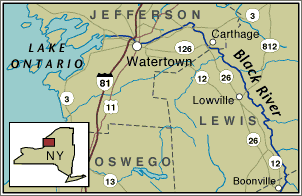River Flow Information
Places To Stay
Black River has been around for nearly 200 years. Back in 1799, French surveyor Pierre Pharoux first explored the region around Watertown, New York, charting boundaries of land claims for French aristocrats hoping to flee Europe before sharing a common fate with Marie Antoinette.
![]() DESTINATIONS Rafting New
York's Black River
DESTINATIONS Rafting New
York's Black River
By Chris Koll
A GORP Content Partner
With whitewater at a premium in the Northeast during the dog days of summer,
wildwater is still to be had on one of the Empire State's premier rivers.
Not many folks realize that whitewater rafting on the Black River has been around for nearly 200 years. Back in 1799, French surveyor Pierre Pharoux first explored the region around Watertown, New York, charting boundaries of land claims for French aristocrats hoping to flee Europe before sharing a common fate with Marie Antoinette.

During his work, Pharoux often forded the Black River at a point just
upstream of what is now the Mill Street bridge in downtown Watertown, using long
poles to push a crude log raft across the water. Unfortunately, Pharoux
attempted a final, fateful crossing after several days of hard rain. The poles
proved too short to reach the bottom of the swollen stream and the raft careened
out of control downriver before plunging over the 25-foot high Great Falls.
Two of Pharoux's assistants managed to swim to shore before the raft reached the
waterfall and a third was thrown clear as the raft launched off the precipice.
But Pharoux was caught in the fearful hydraulic at the base of the falls and
drowned.
No wonder whitewater rafting didn't reappear on the Black until 1982.
Location: Watertown, New York.
The Run: 7 miles with Class III and IV rapids.
Season: All summer, thanks to releases from Stillwater Reservoir and
other impoundments.
Highlights: Knife Edge, three ledged developing boat-flipping hydraulics
at medium and high flows; Glen Park Falls, a portage except for expert kayakers;
100-foot limestone walls lining a gorge of nearly continuous whitewater below
the falls.
The Black High and Dry
Actually, following the industrial revolution of the 1800s, there would not have
been much whitewater to negotiate anyway. The Black tumbles toward Lake Ontario
off the elevated region known as the Tug Hill Plateau in a series of waterfalls
and long rapids at the upstate villages of Port Leyden, Lyon's Falls, Carthage
and Felt's Mills. Then, just shy of the lake, the river makes its final
tumultuous descent plunging 500 vertical feet during a 10-mile stretch at
Watertown.
Settlers were drawn to the area by the abundance of cheap, natural power. Dam
after dam was erected on the Black, especially near Watertown where the stream
was flanked by high limestone cliffs creating a deep and narrow gorge. Rapids
now known as the Great Falls, Hole Brothers, Knifes Edge and Glen Park Falls
were left high and dry as the river was funneled out of its natural channel and
into penstocks to provide power for industry. And within the gorge area, the
numerous wild rapids were buried deep beneath the water impounded behind two
additional dams.
Through the 19th century, Watertown prospered as an industrial center. In fact,
at one point, paper mills located on the banks of the Black River produced most
of the nation's newsprint and a variety of other paper products.
But over the years, Watertown's paper industry faded as new manufacturing
techniques were introduced and the ready supply of pulp wood from the nearby
Adirondacks diminished. The old mills were reduced to picturesque limestone
shells perched like crumbling castles above the river.
And as for the dams? Well, with a river like the Black that typically swells to
20 times its normal volume during spring flood, abandoned dams have a short life
expectancy. One by one the river washed away the man-made impediments and its
rapids thundered once again. The final two dams in the gorge disappeared in the
spring of 1978, revealing a wild river reborn, waiting to be rediscovered by
whitewater rafters and boaters.
Chris Koll is an experienced kayaker and safety boater. Chris is also former
editor of American Whitewater, the official publication of the American
Whitewater Affiliation.
Next - Running The Black